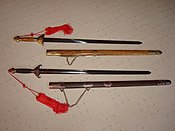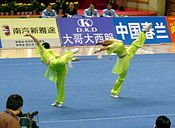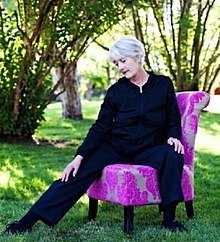
Tai chi

| |
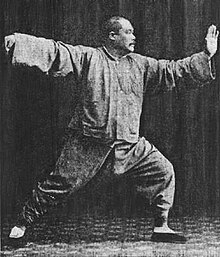
| |
| Also known as | Tàijí; T'ai chi |
|---|---|
| Focus | Chinese Taoism |
| Hardness |
|
| Country of origin | China |
| Creator | Chen Wangting or Zhang Sanfeng |
| Famous practitioners | |
| Olympic sport | Demonstration only |
| Tai chi | |||||||||||||||||||||||||||||
|---|---|---|---|---|---|---|---|---|---|---|---|---|---|---|---|---|---|---|---|---|---|---|---|---|---|---|---|---|---|
| Traditional Chinese | 太極拳 | ||||||||||||||||||||||||||||
| Simplified Chinese | 太极拳 | ||||||||||||||||||||||||||||
| Literal meaning | "Taiji Boxing" | ||||||||||||||||||||||||||||
|
|||||||||||||||||||||||||||||
| Part of a series on |
| Chinese martial arts (Wushu) |
|---|
 |
|
Historical locations
|
|
Legendary figures
|
|
Modern celebrities
|
Tai chi (traditional Chinese: 太極; simplified Chinese: 太极; pinyin: Tàijí), short for Tai chi ch'üan (太極拳; 太极拳; Tàijíquán), sometimes called "shadowboxing", is an internal Chinese martial art practiced for defense training, health benefits and meditation. Tai chi has practitioners worldwide from Asia to the Americas.
Practitioners such as Yang Chengfu and Sun Lutang in the early 20th Century promoted the art for its health benefits. Its global following may be attributed to overall benefit to personal health. Many forms are practiced, both traditional and modern. Most modern styles trace their development to the five traditional schools: Chen, Yang, Wu (Hao), Wu, and Sun. All trace their historical origins to Chen Village, China.
Conceptual background

The philosophical and conceptual background to Tai chi relies on Chinese philosophy, particularly Daoist and Confucian thought as well as on the Chinese classics. Early Tai Chi texts include embedded quotations from classic Chinese works like the Yijing, Great Learning, Book of History, Records of the Grand Historian, Zhu Xi, Zhou Dunyi, Mencius and Zhuangzi.
Early Tai Chi sources also ground Tai Chi in the cosmology of Tai Chi ((太极, tàijí, "Supreme Polarity", or "Greatest Ultimate") from which the art gets its name. Tai Chi cosmology appears in both Taoist and Confucian philosophy, where it represents the single source or mother of yin and yang (represented by the taijitu symbol ![]() ). Tai Chi also draws on Chinese theories of the body, particularly Daoist neidan (internal alchemy) teachings on Qi (vital energy) and on the three dantiens. Zheng Manqing emphasizes the Daoist background of Tai Chi and states that "Taijiquan enables us to reach the stage of undifferentiated pure yang, which is exactly the same as Laozi's 'concentrating the qi and developing softness'".
). Tai Chi also draws on Chinese theories of the body, particularly Daoist neidan (internal alchemy) teachings on Qi (vital energy) and on the three dantiens. Zheng Manqing emphasizes the Daoist background of Tai Chi and states that "Taijiquan enables us to reach the stage of undifferentiated pure yang, which is exactly the same as Laozi's 'concentrating the qi and developing softness'".
As such, Tai Chi considers itself an "internal" martial art which focuses on developing the qi. In China, Tai Chi is categorized under the Wudang grouping of Chinese martial arts—that is, arts applied with internal power. Although the term 'Wudang' suggests these arts originated in the Wudang Mountains, it is used only to distinguish the skills, theories and applications of neijia (internal arts) from those of the Shaolin grouping, or waijia (hard or external) styles.
Tai Chi also adopts the Daoist ideals of softness overcoming hardness, of wu-wei (effortless action), and of yielding into its martial art technique, while also retaining Daoist ideas of spiritual self-cultivation.
Tai Chi's path is one of developing naturalness by relaxing, attending inward, and slowing mind, body and breath. This allows us to become less tense, to drop our conditioned habits, let go of thoughts, allow qi to flow smoothly, and thus to flow with the Dao. It is thus a kind of moving meditation that allows us to let go of the self (wuwo), and experience no-mind (wuxin) and spontaneity (ziran).
A key aspect of Tai Chi philosophy is to work with the flow of yin (softness) and yang (hardness) elements. When two forces push each other with equal force, neither side moves. Motion cannot occur until one side yields. Therefore, a key principle in Tai Chi is to avoid using force directly against force (hardness against hardness). Lao Tzŭ provided the archetype for this in the Tao Te Ching when he wrote, "The soft and the pliable will defeat the hard and strong." Conversely, when in possession of leverage, one may want to use hardness to force the opponent to become soft. Traditionally, Tai Chi uses both soft and hard. Yin is said to be the mother of Yang, using soft power to create hard power.
Traditional schools also emphasize that one is expected to show wude ("martial virtue/heroism"), to protect the defenseless, and show mercy to one's opponents.
In December 2020, the 15th regular session of the UNESCO Intergovernmental Committee for the Safeguarding of the Intangible Cultural Heritage included the "Tai Chi" project in the UNESCO Representative List of the Intangible Cultural Heritage of Humanity.
Practice
Traditionally, the foundational Tai Chi practice consists of learning and practicing a specific solo forms or routines (taolu). This entails learning a routine sequence of movements that emphasize a straight spine, abdominal breathing and a natural range of motion. Tai chi relies on knowing the appropriate change in response to outside forces, as well as on yielding to and redirecting an attack, rather than meeting it with opposing force. Physical fitness is also seen as an important step towards effective self-defense.
There are also numerous other supporting solo practices such as:
- Sitting meditation: The empty, focus and calm the mind and aid in opening the microcosmic orbit.
- Standing meditation (zhan zhuang) to raise the yang qi
- Qigong to mobilize the qi
- Acupressure massage to develop awareness of qi channels
- Traditional Chinese medicine is taught to advanced students in some traditional schools.
Further training entails learning tuishou (push hands drills), sanshou (striking techniques), free sparring, grappling training, and weapons training.
In the "T'ai-chi classics", writings by tai chi masters, it is noted that the physiological and kinesiological aspects of the body's movements are characterized by the circular motion and rotation of the pelvis, based on the metaphors of the pelvis as the hub and the arms and feet as the spokes of a wheel. Furthermore, the respiration of breath is coordinated with the physical movements in a state of deep relaxation, rather than muscular tension, in order to guide the practitioners to a state of homeostasis.
Tai Chi Quan is a complete martial art system with a full range of bare-hand movement sets and weapon forms, such as Tai Chi sword and Tai Chi spear, which are based on the dynamic relationship between Yin and Yang. While Tai Chi is typified by its slow movements, many styles (including the three most popular: Yang, Wu, and Chen) have secondary, faster-paced forms. Some traditional schools teach martial applications of the postures of different forms (taolu).
Solo practices
Taolu (solo "forms") is a choreography that serves as the encyclopedia of a martial art. Tai chi is often characterized by slow movements in Taolu practice, and one of the reasons is to develop body awareness. Accurate, repeated practice of the solo routine is said to retrain posture, encourage circulation throughout students' bodies, maintain flexibility, and familiarize students with the martial sequences implied by the forms. The traditional styles of tai chi have forms that differ in aesthetics, but share many similarities that reflect their common origin.
Solo forms (empty-hand and weapon) are catalogues of movements that are practised individually in pushing hands and martial application scenarios to prepare students for self-defense training. In most traditional schools, variations of the solo forms can be practised: fast / slow, small-circle / large-circle, square / round (different expressions of leverage through the joints), low-sitting/high-sitting (the degree to which weight-bearing knees stay bent throughout the form).
Breathing exercises; neigong (internal skill) or, more commonly, qigong (life energy cultivation) are practiced to develop qi (life energy) in coordination with physical movement and zhan zhuang (standing like a post) or combinations of the two. These were formerly taught as a separate, complementary training system. In the last 60 years they have become better known to the general public. Qigong involves coordinated movement, breath, and awareness used for health, meditation, and martial arts. While many scholars and practitioners consider tai chi to be a type of qigong, the two are commonly seen as separate but closely related practices. Qigong plays an important role in training for tai chi. Many tai chi movements are part of qigong practice. The focus of qigong is typically more on health or meditation than martial applications. Internally the main difference is the flow of qi. In qigong, the flow of qi is held at a gate point for a moment to aid the opening and cleansing of the channels. In tai chi, the flow of qi is continuous, thus allowing the development of power by the practitioner.
Partnered practice
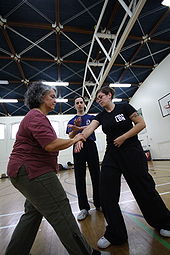
Tai chi's martial aspect relies on sensitivity to the opponent's movements and center of gravity, which dictate appropriate responses. Disrupting the opponent's center of gravity upon contact is the primary goal of the martial t'ai-chi ch'üan student. The sensitivity needed to capture the center is acquired over thousands of hours of first yin (slow, repetitive, meditative, low-impact) and then later adding yang (realistic, active, fast, high-impact) martial training through taolu (forms), tuishou (pushing hands), and sanshou (sparring). Tai chi trains in three basic ranges: close, medium and long. Pushes and open-hand strikes are more common than punches, and kicks are usually to the legs and lower torso, never higher than the hip, depending on style. The fingers, fists, palms, sides of the hands, wrists, forearms, elbows, shoulders, back, hips, knees, and feet are commonly used to strike. Targets are the eyes, throat, heart, groin, and other acupressure points. Chin na, which are joint traps, locks, and breaks are also used. Most tai chi teachers expect their students to thoroughly learn defensive or neutralizing skills first, and a student must demonstrate proficiency with them before learning offensive skills.
Martial schools focus on how the energy of a strike affects the opponent. A palm strike that looks to have the same movement may be performed in such a way that it has a completely different effect on the opponent's body. A palm strike could simply push the opponent backward, or instead be focused in such a way as to lift the opponent vertically off the ground, changing center of gravity; or it could project the force of the strike into the opponent's body with the intent of causing internal damage.
Most development aspects are meant to be covered within the partnered practice of tuishou, and so, sanshou (sparring) is not commonly used as a method of training, although more advanced students sometimes practice by sanshou. Sanshou is more common to tournaments such as wushu tournaments.
Weapon practice
Tai chi practices involving weapons also exist. Weapons training and fencing applications often employ:
- the jian, a straight double-edged sword, practiced as taijijian;
- the dao, a heavier curved saber, sometimes called a broadsword;
- the tieshan, a folding fan, also called shan and practiced as taijishan;
- the gun, a 2 m long wooden staff and practiced as taijigun;
- the qiang, a 2 m long spear or a 4 m long lance.
More exotic weapons include:
- the large dadao and podao sabres;
- the ji, or halberd;
- the cane;
- the sheng biao, or rope dart;
- the sanjiegun, or three sectional staff;
- the feng huo lun, or wind and fire wheels;
- the lasso;
- the whip, chain whip and steel whip.
Attire and ranking
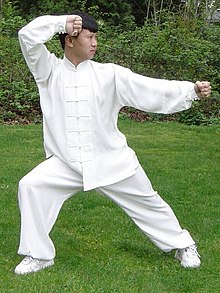
Some martial arts require students to wear a uniform during practice. In general, Tai Chi does not specify a uniform, although teachers often advocate loose, comfortable clothing and flat-soled shoes. Modern day practitioners usually wear comfortable, loose T-shirts and trousers made from breathable natural fabrics, that allow for free movement. Despite this, T'ai-chi ch'üan has become synonymous with "t'ai-chi uniforms" or "kung fu uniforms" that usually consist of loose-fitting traditional Chinese styled trousers and a long or short-sleeved shirt, with a Mandarin collar and buttoned with Chinese frog buttons. The long-sleeved variants are referred to as Northern-style uniforms, whilst the short-sleeved, are Southern-style uniforms.
The clothing may be all white, all black, black and white, or any other colour, mostly a single solid colour or a combination of two colours: one colour for the garment and another for the binding. They are normally made from natural fabrics such as cotton or silk. They are usually worn by masters and professional practitioners during demonstrations, tournaments and other public exhibitions.
Tai chi has no standardized ranking system, except the Chinese Wushu Duan wei exam system run by the Chinese wushu association in Beijing. Most schools do not use belt rankings. Some schools present students with belts depicting rank, similar to dans in Japanese martial arts. A simple uniform element of respect and allegiance to one's teacher and their methods and community, belts also mark hierarchy, skill, and accomplishment. During wushu tournaments, masters and grandmasters often wear "kung fu uniforms" which tend to have no belts. Wearing a belt signifying rank in such a situation would be unusual.
Seated tai chi
Traditional tai chi was developed for self-defense, but it has evolved to include a graceful form of seated exercise now used for stress reduction and other health conditions. Often described as meditation in motion, seated tai chi promotes serenity through gentle, flowing movements. Seated tai chi exercises is touted by the medical community and researchers. It is based primarily on the Yang short form, and has been adopted by the general public, medical practitioners, tai chi instructors, and the elderly. Seated forms are not a simple redesign of the yang short form. Instead, the practice attempts to preserve the integrity of the form, with its inherent logic and purpose. The synchronization of the upper body with the steps and the breathing developed over hundreds of years, and guided the transition to seated positions. Marked improvements in balance, blood pressure levels, flexibility and muscle strength, peak oxygen intake, and body fat percentages can be achieved.
Etymology
Tai Chi was known as "大恒" by the Ancient Chinese. The silk version of I Ching recorded this original name. Due to the name taboo of Emperor Wen of Western Han Empire , "大恒" changed to "太極.". Sundial shadow length changes represent traditional Chinese Medicine with four elements theory instead of Confucian politician-based five elements theory. In the beginning, the color white was associated with Yin, while black was associated with Yang. Confucianism uses the reverse.
The term taiji is a Chinese cosmological concept for the flux of yin and yang. 'Quan' means technique.
Tàijíquán and T'ai-chi ch'üan are two different transcriptions of three Chinese characters that are the written Chinese name for the art form:
| Characters | Wade–Giles | Pinyin | Meaning |
|---|---|---|---|
| 太極 | t'ai chi | tàijí | the relationship of Yin and Yang |
| 拳 | ch'üan | quán | technique |
The English language offers two spellings, one derived from Wade–Giles and the other from the Pinyin transcription. Most Westerners often shorten this name to t'ai chi (often omitting the aspirate sign—thus becoming "tai chi"). This shortened name is the same as that of the t'ai-chi philosophy. However, the Pinyin romanization is taiji. The chi in the name of the martial art is not the same as ch'i (qi 气 the "life force"). Ch'i is involved in the practice of t'ai-chi ch'üan. Although the word 极 is traditionally written chi in English, the closest pronunciation, using English sounds, to that of Standard Chinese would be jee, with j pronounced as in jump and ee pronounced as in bee. Other words exist with pronunciations in which the ch is pronounced as in champ. Thus, it is important to use the j sound. This potential for confusion suggests preferring the pinyin spelling, taiji. Most Chinese use the Pinyin version.
History

Early development
Taijiquan's formative influences came from practices undertaken in Taoist and Buddhist monasteries, such as Wudang, Shaolin and The Thousand Year Temple in Henan. The early development of Tai Chi proper is connected with Henan's Thousand Year Temple and a nexus of nearby villages: Chen Village, Tang Village, Wangbao Village, and Zhaobao Town. These villages were closely connected, shared an interest in the martial arts and many went to study at Thousand Year Temple (which was a syncretic temple with elements from the three teachings). New documents from these villages, mostly dating to the 17th century, are some of the earliest sources for the practice of Taijiquan.
Some traditionalists claim that Tai chi is a purely Chinese art that comes from ancient Daoism and Confucianism. These schools believe that Tai chi theory and practice were formulated by Taoist monk Zhang Sanfeng in the 12th century. These stories are often filled with legendary and hagiographical content and lack historical support.
Modern historians pointing out that the earliest reference indicating a connection between Zhang Sanfeng and martial arts is actually a 17th-century piece called Epitaph for Wang Zhengnan (1669), composed by Huang Zongxi (1610–1695). Aside from this single source, the other claims of connections between Tai chi and Zhang Sanfeng appeared no earlier than the 19th century. According to Douglas Wile, "there is no record of a Zhang Sanfeng in the Song Dynasty (960-1279), and there is no mention in the Ming (1368-1644) histories or hagiographies of Zhang Sanfeng of any connection between the immortal and the material arts."
Another common theory for the origin of Tai Chi is that it was created by Chen Wangting (1580–1660) while living in Chen Village (陳家溝), Henan province. The other four contemporary traditional Taijiquan styles (Yang, Sun, Wu and Wu (Hao)) trace their teachings back to Chen village in the early 1800s.
Yang Luchan (1799–1872), the founder of the popular Yang style, trained with the Chen family for 18 years before he started to teach in Beijing, which strongly suggests that his work was heavily influenced by the Chen family art. Martial arts historian Xu Zhen claimed that the Tai chi of Chen Village was influenced by the Taizu changquan style practiced at nearby Shaolin Monastery, while Tang Hao thought it was derived from a treatise by Ming dynasty general Qi Jiguang, Jixiao Xinshu ("New Treatise on Military Efficiency"), which discussed several martial arts styles including Taizu changquan.
Tai Chi appears to have received the name "Tai Chi" during the mid-19th century. Imperial Court scholar Ong Tong witnessed a demonstration by Yang Luchan before Yang had established his reputation as a teacher. Afterwards Ong wrote: "Hands holding Tai chi shakes the whole world, a chest containing ultimate skill defeats a gathering of heroes." Before this time the art may have had other names, and appears to have been generically described by outsiders as zhan quan (沾拳, "touch boxing"), Mian Quan ("soft boxing") or shisan shi (十三式, "the thirteen techniques").
Standardization
In 1956 the Chinese government sponsored the Chinese Sports Committee (CSC), which brought together four wushu teachers to truncate the Yang family hand form to 24 postures. This was an attempt to standardize T'ai-chi ch'üan for wushu tournaments as they wanted to create a routine that would be much less difficult to learn than the classical 88 to 108 posture solo hand forms.
Another 1950s form is the "97 movements combined t'ai-chi ch'üan form", which blends Yang, Wu, Sun, Chen, and Fu styles.
In 1976, they developed a slightly longer demonstration form that would not require the traditional forms' memory, balance, and coordination. This became the "Combined 48 Forms" that were created by three wushu coaches, headed by Men Hui Feng. The combined forms simplified and combined classical forms from the original Chen, Yang, Wu, and Sun styles. Other competitive forms were designed to be completed within a six-minute time limit.
In the late 1980s, CSC standardized more competition forms for the four major styles as well as combined forms. These five sets of forms were created by different teams, and later approved by a committee of wushu coaches in China. These forms were named after their style: the "Chen-style national competition form" is the "56 Forms". The combined forms are "The 42-Form" or simply the "Competition Form".
In the 11th Asian Games of 1990, wushu was included as an item for competition for the first time with the 42-Form representing t'ai-chi ch'üan. The International Wushu Federation (IWUF) applied for wushu to be part of the Olympic games.
Taijiquan was added to the UNESCO Intangible Cultural Heritage Lists in 2020 for China.
Styles
Chinese origin
The five major styles of tai chi are named for the Chinese families who originated them:
- Chen style (陳氏) of Chen Wangting (1580–1660)
- Yang style (楊氏) of Yang Luchan (1799–1872)
- Wu Hao style (武氏) of Wu Yuxiang (1812–1880)
- Wu style (吳氏) of Wu Quanyou (1834–1902) and his son Wu Jianquan (1870–1942)
- Sun style (孫氏) of Sun Lutang (1861–1932)
The most popular is Yang, followed by Wu, Chen, Sun and Wu/Hao. The styles share underlying theory, but their training differs.
Dozens of new styles, hybrid styles, and offshoots followed, although the family schools are accepted as standard by the international community. Other important styles are Zhaobao tàijíquán, a close cousin of Chen style, which is recognized by Western practitioners; Fu style, created by Fu Chen Sung, which evolved from Chen, Sun and Yang styles, and incorporates movements from Baguazhang (Pa Kua Chang); and Cheng Man-ch'ing style which simplifies Yang style.
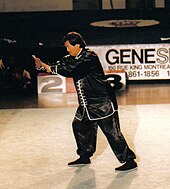
Most existing styles came from Chen style, which had been passed down as a family secret for generations. The Chen family chronicles record Chen Wangting, of the family's 9th generation, as the inventor of what is known today as tai chi. Yang Luchan became the first person outside the family to learn tai chi. His success in fighting earned him the nickname Yang Wudi, which means "Abnormally Large", and his fame and efforts in teaching greatly contributed to the subsequent spreading of tai chi knowledge. The designation internal or neijia martial arts is also used to broadly distinguish what are known as external or waijia styles based on Shaolinquan styles, although that distinction may be disputed by modern schools. In this broad sense, all styles of t'ai chi, as well as related arts such as Baguazhang and Xingyiquan, are, therefore, considered to be "soft" or "internal" martial arts.
United States
Choy Hok Pang, a disciple of Yang Chengfu, was the first known proponent of tai chi to openly teach in the United States, beginning in 1939. His son and student Choy Kam Man emigrated to San Francisco from Hong Kong in 1949 to teach t'ai-chi ch'üan in Chinatown. Choy Kam Man taught until he died in 1994.
Sophia Delza, a professional dancer and student of Ma Yueliang, performed the first known public demonstration of tai chi in the United States at the New York City Museum of Modern Art in 1954. She wrote the first English language book on t'ai-chi, "T'ai-chi ch'üan: Body and Mind in Harmony", in 1961. She taught regular classes at Carnegie Hall, the Actors Studio, and the United Nations.
Zheng Manqing/Cheng Man-ch'ing, who opened his school Shr Jung t'ai-chi after he moved to New York from Taiwan in 1964. Unlike the older generation of practitioners, Zheng was cultured and educated in American ways, and thus was able to transcribe Yang's dictation into a written manuscript that became the de facto manual for Yang style. Zheng felt Yang's traditional 108-movement form was unnecessarily long and repetitive, which makes it difficult to learn. He thus created a shortened 37-movement version that he taught in his schools. Zheng's form became the dominant form in the eastern United States until other teachers immigrated in larger numbers in the 1990s. He taught until his death in 1975.
United Kingdom
Norwegian Pytt Geddes was the first European to teach tai chi in Britain, holding classes at The Place in London in the early 1960s. She had first encountered tai chi in Shanghai in 1948, and studied with Choy Hok Pang and his son Choy Kam Man (who both also taught in the United States) while living in Hong Kong in the late 1950s.
Lineage
Note:
- This lineage tree is not comprehensive, but depicts those considered the "gate-keepers" and most recognised individuals in each generation of the respective styles.
- Although many styles were passed down to respective descendants of the same family, the lineage focused on is that of the martial art and its main styles, not necessarily that of the families.
- Each (coloured) style depicted below has a lineage tree on its respective article page that is focused on that specific style, showing a greater insight into the highly significant individuals in its lineage.
- Names denoted by an asterisk are legendary or semi-legendary figures in the lineage; while their involvement in the lineage is accepted by most of the major schools, it is not independently verifiable from known historical records.
| Key: | |||||||||||||||||||||||||||||||||||||||||||||||||||||||||||||||||||||||||||||||||||||||||
| Solid lines | Direct teacher-student. | (张三丰) Zhang Sanfeng* c. 12th century NEIJIA |
|||||||||||||||||||||||||||||||||||||||||||||||||||||||||||||||||||||||||||||||||||||||
| Dashed lines | Individual(s) omitted. | Various Daoists | Legendary figures | ||||||||||||||||||||||||||||||||||||||||||||||||||||||||||||||||||||||||||||||||||||||
| Dotted lines | Partial influence /taught informally /limited time. |
(王宗岳) Wang Zongyue* TAIJIQUAN |
|||||||||||||||||||||||||||||||||||||||||||||||||||||||||||||||||||||||||||||||||||||||
| Dashed cross | Branch continues. | ||||||||||||||||||||||||||||||||||||||||||||||||||||||||||||||||||||||||||||||||||||||||
| (陈王庭) Chen Wangting 1580–1660 CHEN-STYLE |
(蒋法) Jiang Fa Zhaobao-style |
||||||||||||||||||||||||||||||||||||||||||||||||||||||||||||||||||||||||||||||||||||||||
| (陈汝信) Chen Ruxin 2nd gen. Chen |
(陈所乐) Chen Suole 2nd gen. Chen |
(邢喜怀) Xing Xihuai 2nd gen. Zhaobao |
|||||||||||||||||||||||||||||||||||||||||||||||||||||||||||||||||||||||||||||||||||||||
| (陈大鹍) Chen Dakun 3rd gen. Chen |
(陈大鹏) Chen Dapeng 3rd gen. Chen |
(陈光印) Chen Guangyin 3rd gen. Chen |
(陈申如) Chen Shenru 3rd gen. Chen |
(陈恂如) Chen Xunru 3rd gen. Chen |
(陈正如) Chen Zhengru 3rd gen. Chen |
(张楚臣) Zhang Chuchen 3rd gen. Zhaobao |
|||||||||||||||||||||||||||||||||||||||||||||||||||||||||||||||||||||||||||||||||||
| (陈善通) Chen Shantong 4th gen. Chen |
(陈善志) Chen Shanzhi 4th gen. Chen |
(陈继夏) Chen Jixia 4th gen. Chen |
(陈节) Chen Jie 4th gen. Chen |
(陈敬伯) Chen Jingbo 4th gen. Chen 4th gen. Zhaobao |
|||||||||||||||||||||||||||||||||||||||||||||||||||||||||||||||||||||||||||||||||||||
| (陈秉奇) Chen Bingqi 5th gen. Chen |
(陈秉壬) Chen Bingren 5th gen. Chen |
(陈秉旺) Chen Bingwang 1748–? 5th gen. Chen |
(陈公兆) Chen Gongzhao 1715– after 1795 5th gen. Chen |
(张宗禹) Zhang Zongyu 5th gen. Zhaobao |
|||||||||||||||||||||||||||||||||||||||||||||||||||||||||||||||||||||||||||||||||||||
| (陈长兴) Chen Changxing 1771–1853 6th gen. Chen Chen Old Frame |
(陈有本) Chen Youben c. 19th century 6th gen. Chen Chen Small Frame |
(张彦) Zhang Yan 6th gen. Zhaobao |
|||||||||||||||||||||||||||||||||||||||||||||||||||||||||||||||||||||||||||||||||||||||
| (陈耕耘) Chen Gengyun 7th gen. Chen |
(陈仲甡) Chen Zhongshen 1809–1871 7th gen. Chen Chen Small Frame |
(杨露禅) Yang Luchan 1799–1872 YANG-STYLE Guang Ping Yang Yangjia Michuan |
(陈清萍) Chen Qingping 1795–1868 7th gen. Chen 7th gen. Zhaobao |
||||||||||||||||||||||||||||||||||||||||||||||||||||||||||||||||||||||||||||||||||||||
| (陈延熙) Chen Yanxi 8th gen. Chen |
(陈鑫) Chen Xin 1849–1929 8th gen. Chen Chen Small Frame |
(王兰亭) Wang Lanting 1840–? 2nd gen. Yang |
(杨健侯) Yang Jianhou 1839–1917 2nd gen. Yang 2nd gen. Yangjia Michuan |
(杨班侯) Yang Banhou 1837–1892 2nd gen. Yang 2nd gen. Guang Ping Yang Yang Small Frame |
(武禹襄) Wu Yuxiang 1812–1880 WU (HAO)-STYLE |
(他招远) He Zhaoyuan 1810–1890 8th gen. Zhaobao Zhaobao He-style |
|||||||||||||||||||||||||||||||||||||||||||||||||||||||||||||||||||||||||||||||||||
| (陈发科) Chen Fake 1887–1957 9th gen. Chen Chen New Frame |
(陈克忠) Chen Kezhong 1908–1966 9th gen. Chen Chen Small Frame |
(李瑞东) Li Ruidong 1851–1917 Li-style |
(杨澄甫) Yang Chengfu 1883–1936 3rd gen. Yang Yang Big Frame |
(杨少侯) Yang Shaohou 1862–1930 3rd gen. Yang Yang Small Frame |
(吴全佑) Wu Quanyou 1834–1902 1st gen. Wu |
(王矯宇) Wang Jiaoyu 1836–1939 3rd gen. Guang Ping Yang |
(李亦畬) Li Yiyu 1832–1892 2nd gen. Wu (Hao) |
(和庆喜) He Qingxi 1857–1936 9th gen. Zhaobao |
|||||||||||||||||||||||||||||||||||||||||||||||||||||||||||||||||||||||||||||||||
| (陈照丕) Chen Zhaopi 1893–1972 10th gen. Chen focused on Chen Old Frame |
(陈照奎) Chen Zhaokui 1928–1981 10th gen. Chen focused on Chen New Frame |
(陈伯祥) Chen Boxiang b. 1944 10th gen. Chen Chen Small Frame |
(張欽霖) Zhang Qinlin 1888–1967 3rd gen. Yangjia Michuan |
(杨振铎) Yang Zhenduo b. 1926 4th gen. Yang |
(傅仲文) Fu Zhongwen 1903–1994 4th gen. Yang Beijing (24) form |
(郑曼青) Zheng Manqing 1902–1975 4th gen. Yang Short (37) Form |
(吴鉴泉) Wu Jianquan 1870–1942 2nd gen. Wu WU-STYLE 108 Form |
Kuo Lien Ying 1895–1984 4th gen. Guang Ping Yang |
(郝為真) Hao Weizhen 1849–1920 3rd gen. Wu (Hao) |
(郑悟清) Zheng Wuqing 1895–1984 10th gen. Zhaobao |
|||||||||||||||||||||||||||||||||||||||||||||||||||||||||||||||||||||||||||||||
| (吴公儀) Wu Gongyi 1900–1970 3rd gen. Wu |
(孙禄堂) Sun Lutang 1861–1932 SUN-STYLE |
(郝月如) Hao Yueru 1877–1935 4th gen. Wu (Hao) |
|||||||||||||||||||||||||||||||||||||||||||||||||||||||||||||||||||||||||||||||||||||||
| (王延年) Wang Yannian 1914–2008 5th gen. Yang 4th gen. Yangjia Michuan |
(鄭天熊) Zheng Tianxiong 1930–2005 Wudang-style |
(吴雁霞) Wu Yanxia 1930–2001 4th gen. Wu |
(孙剑云) Sun Jianyun 1913–2003 2nd gen. Sun |
(郝少如) Hao Shaoru 1908–1983 5th gen. Wu (Hao) |
|||||||||||||||||||||||||||||||||||||||||||||||||||||||||||||||||||||||||||||||||||||
| (陈小旺) Chen Xiaowang b. 1945 11th gen. Chen |
(陈小星) Chen Xiaoxing b. 1952 11th gen. Chen |
(陆志众) Lu Zhizhong b. 1965 11th gen. Chen Chen Small Frame |
(杨军) Yang Jun b. 1968 5th gen. Yang |
(吴光宇) Wu Guangyu b. 1946 5th gen. Wu |
(孙永田) Sun Yongtian b. ? 3rd gen. Sun |
(刘积顺) Liu Jishun b. 1930 6th gen. Wu (Hao) |
|||||||||||||||||||||||||||||||||||||||||||||||||||||||||||||||||||||||||||||||||||
| CHEN-STYLE | Chen Small Frame | YANG-STYLE | WU-STYLE | SUN-STYLE | WU (HAO)-STYLE | ||||||||||||||||||||||||||||||||||||||||||||||||||||||||||||||||||||||||||||||||||||
Modern forms
The Cheng Man-ch'ing (Zheng Manqing) and Chinese Sports Commission short forms are derived from Yang family forms, but neither is recognized as Yang family tai chi by standard-bearing Yang family teachers. The Chen, Yang, and Wu families promote their own shortened demonstration forms for competitive purposes.
| (杨澄甫) Yang Chengfu 1883–1936 3rd gen. Yang Yang Big Frame | |||||||||||||
| (郑曼青) Zheng Manqing 1902–1975 4th gen. Yang Short (37) Form |
Chinese Sports Commission 1956 Beijing (24) Form |
||||||||||||
| 1989 42 Competition Form (Wushu competition form combined from Chen, Yang, Wu & Sun styles) |
|||||||||||||
Purposes
The primary purposes of tai chi are health, sport/self-defense and aesthetics.
Practitioners mostly interested in tai chi's health benefits diverged from those who emphasize self-defense, and also those who attracted by its aesthetic appeal (wushu).
More traditional practitioners hold that the two aspects of health and martial arts make up the art's yin and yang. The "family" schools present their teachings in a martial art context, whatever the intention of their students.
Health
Tai chi's health training concentrates on relieving stress on the body and mind. In the 21st century, Tai chi classes that purely emphasize health are popular in hospitals, clinics, community centers and senior centers. Tai chi's low-stress training method for seniors has become better known.
Clinical studies exploring Tai chi's effect on specific diseases and health conditions exist, though there are not sufficient studies with consistent approaches to generate a comprehensive conclusion.
Tai chi has been promoted for treating various ailments, and is supported by the Parkinson's Foundation and Diabetes Australia, among others. However, medical evidence of effectiveness is lacking and research has been undertaken to address this. A 2017 systematic review found that it decreased falls in older people.
Sport and self-defense
As a martial art, tai chi emphasizes defense over attack and replies to hard with soft. The ability to use tai chi as a form of combat is the test of a student's understanding of the art. This is typically demonstrated via competition with others.
Practitioners test their skills against students from other schools and martial arts styles in tuishou ("pushing hands") and sanshou competition.
Wushu
Wushu is primarily for show. Tai Chi is part of martial arts, a traditional Chinese activity mainly used for self-defense and physical exercise. Mainly through physical exercise and habitual training to strengthen the muscles of combat and defense, so as to achieve the purpose of actual combat. In ancient China, people gained the ability and possibility to survive in war by practicing martial arts. However, with the development of time, many practical techniques have been retained and lost. In China, there is a tradition of teaching martial arts families, which leads to the possibility of losing the core skills of martial arts. But martial arts has always had the function of strengthening the body and self-defense on the battlefield. Taijiquan also has fighting ability in the early stage, but with the promotion, the effect of strengthening the body is becoming more and more obvious. Today's forms of martial arts are designed to score points in competitions, and are mostly not concerned with health or self-defense.
Benefits
A 2011 comprehensive overview of systematic reviews of tai chi recommended tai chi to older people for its physical and psychological benefits. It found possitive results for fall prevention and overall mental health. No conclusive evidence showed benefit for most of the conditions researched, including Parkinson's disease, diabetes, cancer and arthritis.
A 2015 systematic review found that tai chi could be performed by those with chronic medical conditions such as chronic obstructive pulmonary disease, heart failure, and osteoarthritis without negative effects, and found favorable effects on functional exercise capacity .
In 2015 the Australian Government's Department of Health published the results of a review of alternative therapies that sought to identify any that were suitable for coverage by health insurance. T'ai-chi was one of 17 therapies evaluated. The study concluded that low-quality evidence suggests that tai chi may have some beneficial health effects when compared to control in a limited number of populations for a limited number of outcomes.
A 2020 review of 13 studies found that tai chi had positive effect on the quality of life and depressive symptoms of older adults with chronic conditions who lived in community settings.
In 2022, the U.S.A agency the National Institutes of Health published an analysis of various health claims, studies and findings. They concluded the evidence was of low quality, but that it appears to have a small positive effect on quality of life.
See also
Further reading
Books
- Gaffney, David; Sim, Davidine Siaw-Voon (2014). The Essence of Taijiquan. CreateSpace Independent Publishing Platform. ISBN 978-1-5006-0923-8.
- Bluestein, Jonathan (2014). Research of Martial Arts. CreateSpace Independent Publishing Platform. ISBN 978-1-4991-2251-0.
- Yang, Yang; Grubisich, Scott A. (2008). Taijiquan: The Art of Nurturing, The Science of Power (2nd ed.). Zhenwu Publication. ISBN 978-0-9740990-1-9.
- Frantzis, Bruce (2007). The Power of Internal Martial Arts and Chi: Combat and Energy Secrets of Ba Gua, Tai Chi and Hsing-I. Blue Snake Books. ISBN 978-1-58394-190-4.
- Davis, Barbara (2004). Taijiquan Classics: An Annotated Translation. North Atlantic Books. ISBN 978-1-55643-431-0.
- Eberhard, Wolfram (1986). A Dictionary of Chinese Symbols: Hidden Symbols in Chinese Life and Thought. Routledge & Kegan Paul, London. ISBN 0-415-00228-1.
- Choy, Kam Man (1985). Tai Chi Chuan. San Francisco, California: Memorial Edition 1994.
- Agar-Hutton, Robert (2018), The Metamorphosis of Tai Chi: Created to kill; evolved to heal; teaching peace. Ex-L-Ence Publishing. ISBN 978-1-9164944-1-1
- Wile, Douglas (1983). Tai Chi Touchstones: Yang Family Secret Transmissions. Sweet Ch'i Press. ISBN 978-0-912059-01-3.
- Bond, Joey (1999). See Man Jump See God Fall: Tai Chi Vs. Technology. International Promotions Promotion Pub. ISBN 978-1-57901-001-0.
Magazines
External links
- Tai Chi in Asheville NC
- Tai Chi in Memphis TN
- Tai Chi In Spartanburg SC
- Tai Chi In Brick NJ
- Tai Chi in Pleasanton CA
- Tai Chi in New York NY
| Main topics | ||
|---|---|---|
| TCM and philosophy | ||
| Traditional practices | ||
| Qigong forms and styles | ||
| Qigong masters |
|
|
| Spiritual movements and politics | ||
| Related topics | ||
| Main taolu events | |
|---|---|
| Sparring | |
| Related | |
| |||||||||||||||||||||||||||||
| |||||||||||||||||||||||||||||

